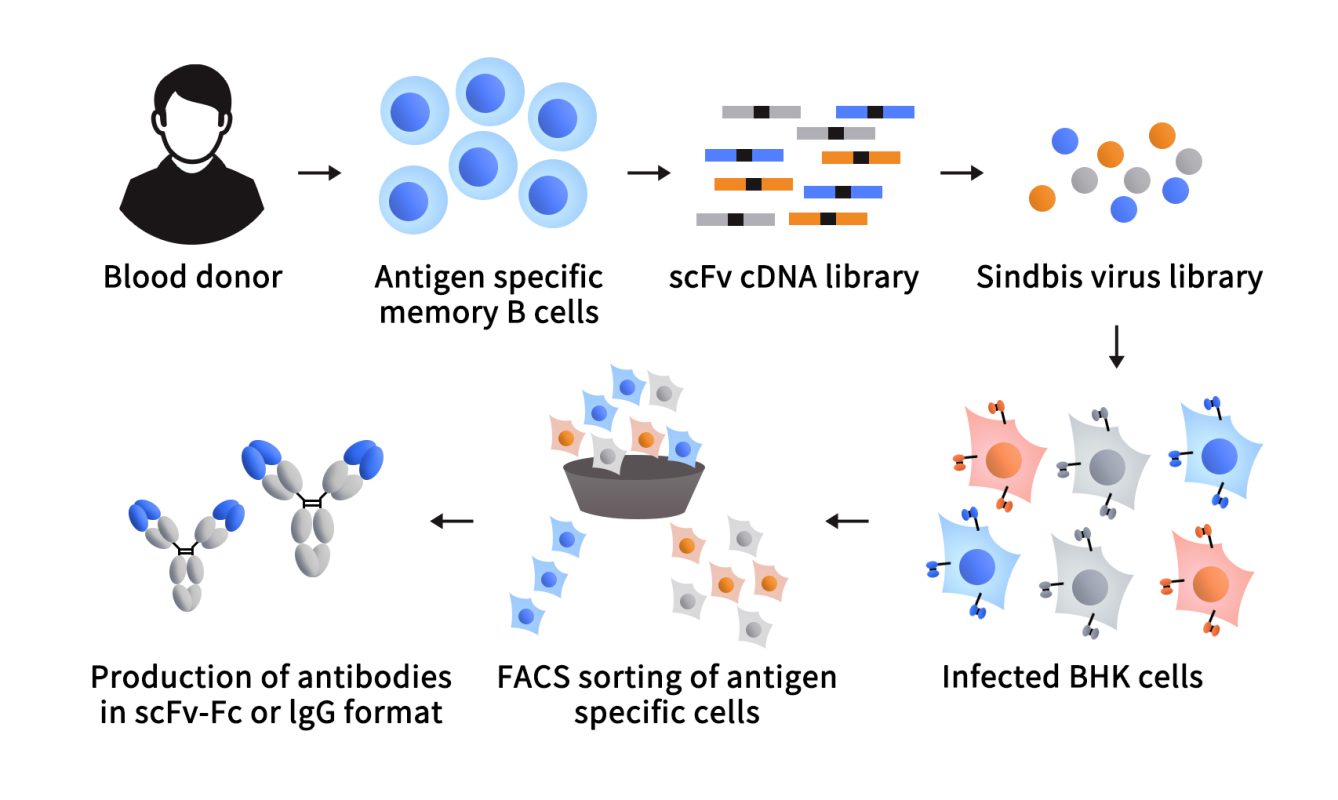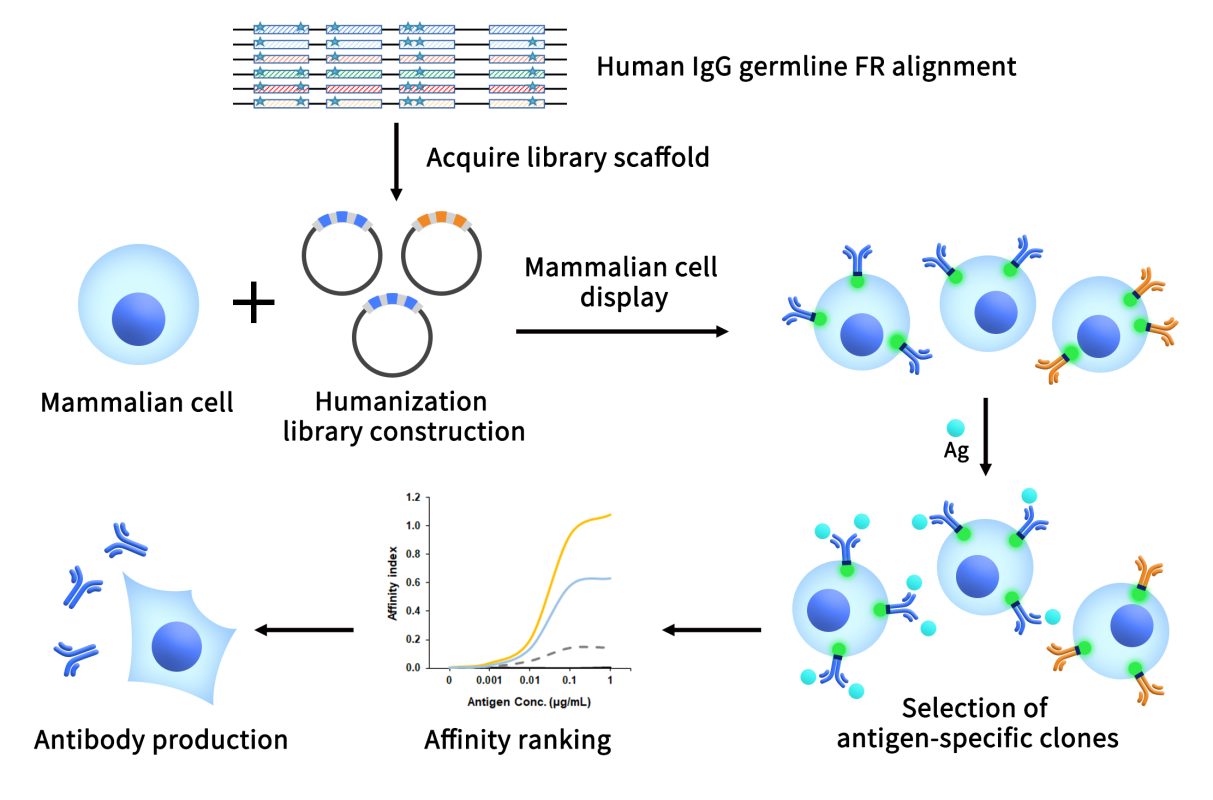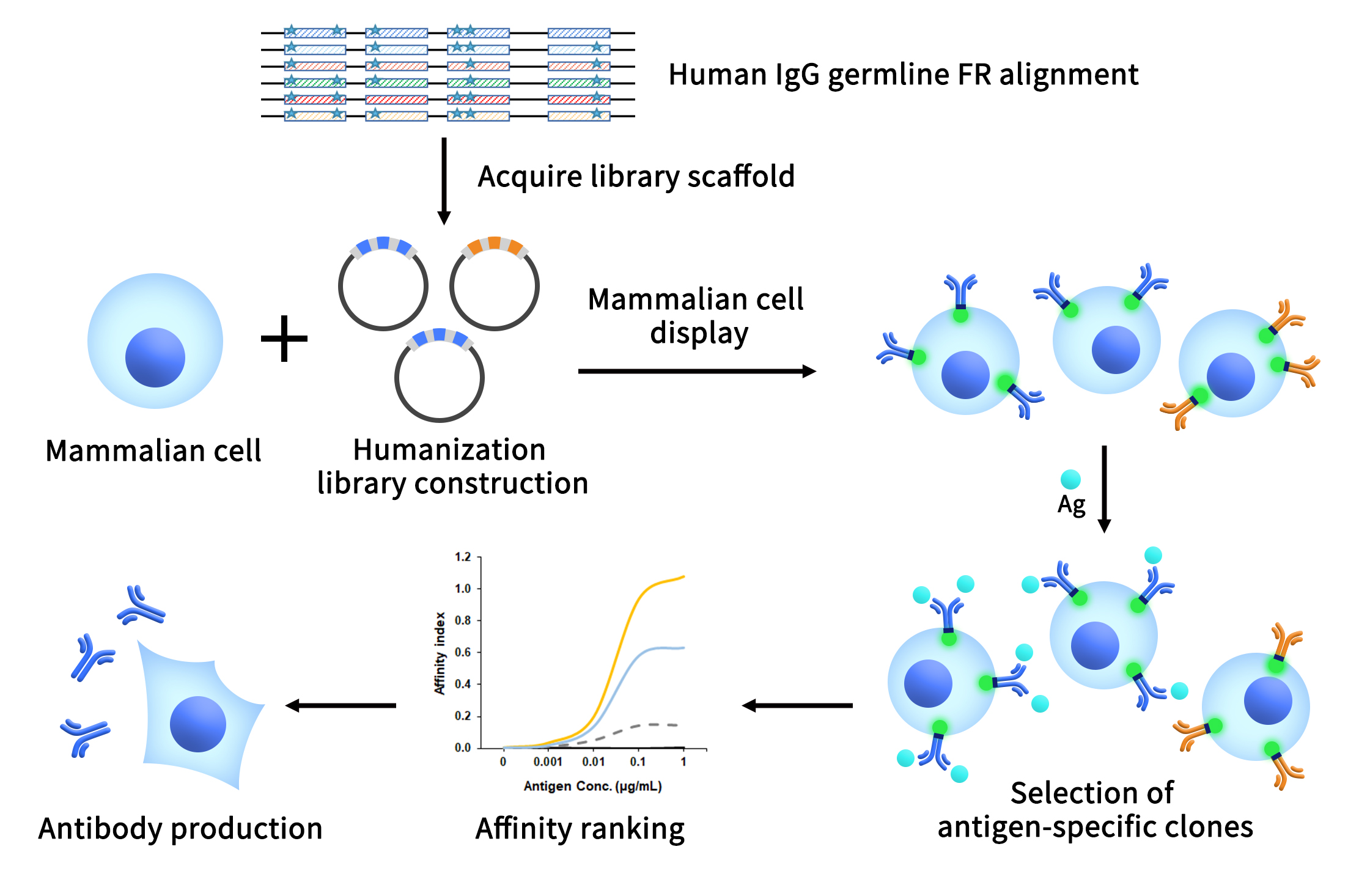In 1986, the world’s first monoclonal therapeutic drug, Orthoclone (OKT3), was approved by the FDA for its use in preventing rejection reactions during organ transplantation. Since then, antibody drugs have started gaining traction and incited an increasing number of research in this area. By the end of January 2023, the FDA has approved 119 antibody drugs, and the list keeps going on. A study published by Precedence Research’s sister company, Towards Healthcare, underscores the enormous growth potential and market space in the global antibody market, with projected revenue expected to reach about $412.36 billion by 2028.
At present, antibody engineering based on display platforms is critical for obtaining high-quality antibody molecules in the monoclonal antibody R&D process. Nowadays many display platforms are available, including phage display, yeast display, ribosome display, and mammalian cell display, among which mammalian cell display exhibits its unique advantages. What is mammalian cell display (MCD)? What are the advantages of MCD? Can MCD be applied to other areas in addition to antibody engineering?
- What is the development of mammalian cell display?
- What is the principle of mammalian cell display?
- What are the advantages of mammalian cell display?
- What are the applications of mammalian cell display?
- DiLibraryTM mammalian display platform for antibody engineering
1. What is the development of mammalian cell display?
The development of mammalian cell display technology represents a significant milestone in the field of antibody engineering. It involves the creation of specialized systems that enable the surface presentation of antibodies or antibody fragments on the surface of mammalian cells, such as CHO (Chinese hamster ovary) cells or HEK (human embryonic kidney) cells. This technology has evolved over the years to become a powerful tool for the efficient generation and screening of high-affinity antibodies. Roger R. Beerli and his colleagues made a significant breakthrough in the field of antibody technology by successfully establishing mammalian cell surface display technology using the Sindbis virus expression system in 2008. This marked a pivotal moment in the development of this innovative approach.
In this study, first, B cells were isolated from the peripheral blood mononuclear cells (PBMC) of human donors, and antibody genes were then isolated and cloned to generate a viral library of antibodies in a single-chain Fv (scFv) format, in which the antibodies were fused with a C-terminal PDGFR transmembrane domain (TM) and an N-terminal mouse Igκ-signal sequence (SP) to facilitate their translocation to membrane. Then, Baby hamster kidney cells (BHK cells) were infected with the viral library such that antibodies were displayed on the BHK cell membrane. As a result, antibodies were presented on the surface of these BHK cells. This innovative method enabled the display of antibodies in either complete IgG form or as Fab fragments. The antibodies displayed on the cell membrane were then screened using fluorescence-activated cell sorting (FACS). This approach allowed for the isolation of antigen-specific antibodies efficiently [1].

Figure 1. Construction of mammalian cell display system using Sinderbise virus [1]
In 2012, a pivotal development in the field of hepatitis B virus (HBV) research occurred when Li and colleagues constructed a secondary antibody library using mammalian cell display technology. Specifically, they utilized a light-chain antibody library and a heavy-chain antibody library, both of which were designed to target HBV-specific antibodies. Through this innovative approach, they successfully screened and identified HBV-specific antibodies, offering a ray of new hope for the treatment and prevention of HBV infection [2]. This breakthrough represents a significant step forward in our efforts to combat HBV, a major global health concern.
2. What is the principle of mammalian cell display?
Mammalian cell display technology refers to the fusion expression of the targeted gene sequence with the transmembrane sequence of mammalian cell receptors by recombinant DNA technology, and the recombinant targeted proteins are displayed on the surface of mammalian cells by the membrane localization function of the transmembrane region of the receptor. Taking mammalian cell antibody display technology as an example, this technology is to screen and obtain recombinant therapeutic monoclonal antibodies by using the expression of antibodies on the cell surface. It mainly includes four steps, including the construction of vectors, transfection cells, expression of antigen and antigen recognition. The first two steps can be collectively referred to as the construction of the mammalian cell surface display antibody library. The last step is also referred to as the enrichment and screening of targeted specific binding antibodies. Chinese hamster ovary (CHO) cells and human embryonic kidney 293 (HEK293) cells are the most widely used mammalian expression systems in mammalian cell display techniques. Now, the vectors suitable for these expression systems include pcDNA series vectors, pDGB vectors and some viral vectors.
3. What are the advantages of mammalian cell display?
With the development of cell display technology, the display system of cell display technology has evolved from prokaryotic cell display system to eukaryotic cell display system. Phage display system is the representative of prokaryotic cell display system, which is also the earliest developed and most widely used display technique. Yeast display system and mammalian cell display system are representatives of eukaryotic display system. Each display system has its own advantages and disadvantages.
Compared with other display systems, mammalian cell display system has significant advantages in antibody drug development. Its expression system is most similar to that of human body, which can guide the correct folding of proteins after translation and provide complex post-translational processing and modification. The products expressed by mammalian cell display technology are closer to natural higher biological protein molecules in terms of molecular structure and biological function.
But mammalian cells proliferate more slowly than microbial cells. The display capacity constructed by mammalian cell display platform is lower than that of phage or yeast display platform. So the mammalian cell display platform is suitable for the screening of immune or directional engineering libraries with small storage capacity rather than naive library screening with particularly large throughput. Some of the characteristics of phage display systems and mammalian cell display systems are compared in the following table:
| Phage display system | Mammalian cell display system | |
| Type | prokaryotic | eukaryotic |
| Antibody display form | ScFv & Fab | IgG & ScFv & Fab |
| Posttranslational modification | No | Yes |
| Production cycle | Short | Long |
| Library capacity | >10^10 | 10^6-10^8 |
| Cost | Low | High |
| Preparation process | Simple | Complex |
Compared with mammalian cell display technology, there is an unpredictable deviation in the fusion expression of targeted proteins or peptides and capsid proteins by using phage display system. In addition, the molecular weight of the targeted protein or polypeptide being displayed cannot be too large, otherwise it will affect the phage’s assembly, reducing its ability to infect the host.
The yeast display system, a eukaryotic display system, also has some limitations. First, the yeast display system can only display specific types of targeted proteins. Second, yeast has the possibility of excessive glycosylation when expressing foreign proteins, so it can only be used to produce functional proteins without glycosylation sites. Third, the post-translation modifications of protein in the yeast is very different from that in mammalian cells, which cannot restore the natural state of the target protein as much as the mammalian cell expression system. In addition, the genetic stability of yeast is poor, and it is easy to lose in the process of passage, resulting in difficult to reproduce the experimental results.
4. What are the applications of mammalian cell display?
Thanks to mammalian cell display technology has obvious advantages in post-translational modification and expression of glycoproteins, it can effectively solve the problems in the expression system of prokaryotic cells. It can not only display full-length antibodies, but also use eukaryotic expression system to guide the correct folding of proteins and provide a variety of post-translational modifications such as complex N-type glycosylation and accurate O-type glycosylation. The molecular structure and biochemical properties of recombinant proteins synthesized mammalian cell expression system are very similar to that of the nature proteins in human beings. Hence, mammalian cell display not only is applied to R&D antibody drug, peptide drug research and development, but also plays a role in vaccine research and development, biological therapy, and diagnosis.
In addition to antibody screening, mammalian cell display technology can be applied in many other ways. For example, it can be used to study the pathogenesis and signaling pathways of disease, and to develop novel drug targets, identify and screen diagnostic markers of disease. The research of constructing and screening recombinant therapeutic monoclonal antibodies through mammalian cell display technology provides an important platform for further development and innovation in the field of biomedicine. For disease treatment and drug development, the application of this technology has great potential to bring more benefits to human health.
5. DiLibraryTM mammalian display platform for antibody engineering
It is the most effective solution that uses animal immunization to develop therapeutic antibodies, but unmodified animal-derived antibodies cannot be used clinically. The humanization of antibody is a necessary stage in the development of antibody drugs. DIMA is committed to providing preclinical research and development products and services for drug targets, aiming to enable drug companies to cross the threshold of mAb platform establishment and screening of lead antibodies, and accelerating the advancement of clinical pipelines. To this end, DIMA has built a DiLibrary™ mammalian display platform for antibody engineering, which can be used for deep humanization of antibodies (humanization while improving affinity), antibody affinity maturation, engineering transformation of nanobodies and TCR, as well as other species antibody transformation such as canine- and feline- .
- The process of DIMA Service

Figure 2 The service process of DiLibrary mammalian display platform for antibody engineering
- BCMA antibody humanization case display
After screening with a library of humanized antibodies constructed by DIMA, we obtained clones with higher affinity than maternal chimeric antibodies, the affinity of which increased to pM level.

- CEACAM5 antibody humanization case display
The affinity of CEACAM5 antibody was completely lost when it was humanized by conventional computer-aided design. A clone with higher affinity than chimeric antibody was obtained after screening with a library of humanized antibodies constructed by DIMA.

- CCR8 antibody affinity maturation case display
The original clone is suboptimal in binding affinity. To improve its binding affinity towards both human and cyno CCR8 protein, affinity maturation was carried out by using DIMA’s DiLibrary technology. Through SPR affinity measurement and other binding assays (ELISA and Flow cytometry), one of the isolated variant clones exhibits around 100 times improvement on binding affinity than original clone. In the meantime, the selected clone gains several fold increases on binding affinity towards cyno CCR8. Sequence analyses demonstrates that two single amino acid change are identified on LCDR3 and HCDR3 of parental molecule.

DIMA BIOTECH, as a professional company focused on the preclinical development of antibody drugs, has carried out in-depth layout of the upstream and downstream development of high-quality lead molecules. In order to obtain high quality and the most natural conformation of multi-transmembrane protein antibodies, we also built a multi-transmembrane protein antigen preparation platform based on mammalian cell expression system, which makes full use of the advantages of the mammalian cell expression system, can prepare and produce full-length functional multi-transmembrane proteins, and ensure the natural conformation of recombinant proteins to the greatest extent. Find a link to know more about DIMA’s Nanodisc…
Reference:
[1] Beerli RR, Bauer M, Buser RB, Gwerder M, Muntwiler S, Maurer P, Saudan P, Bachmann MF. Isolation of human monoclonal antibodies by mammalian cell display. Proc Natl Acad Sci U S A. 2008 Sep 23;105(38):14336-41. [2] Li CZ, Liang ZK,Chen ZR,et al. Identification of HBsAg-specificantibodies from a mammalian cell displayed full-length humanantibody library of healthy immunized donor [J]. Cell MolImmunol, 2012,9(2):184-90.
